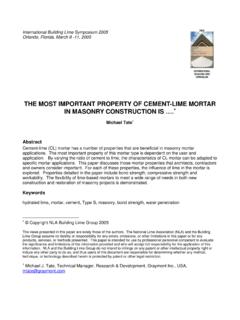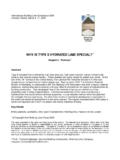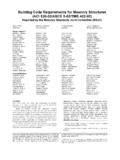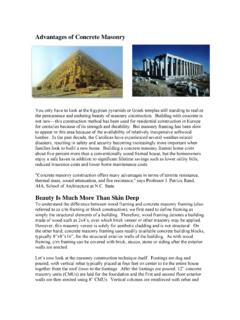Transcription of GROUTING MASONRY USING PORTLAND CEMENT-LIME …
1 International Building Lime Symposium 2005 Orlando, Florida, March 9 -11, 2005 GROUTING MASONRY USING PORTLAND CEMENT-LIME MORTARS David T. Biggs, 1 Abstract For commercial construction, MASONRY standards require that grout be used in reinforced MASONRY construction. Grout is made from a mixture of PORTLAND cement and aggregates with a maximum lime content of one-tenth the volume of the cement. For residential work, some standards allow reinforcing bars to be embedded in Type S or M mortar if modified by adding sufficient water to make the mixture pourable . This research indicates that PORTLAND CEMENT-LIME based mortar has the potential to be an acceptable alternative for grout in reinforced MASONRY in modified, low-lift applications.
2 In addition, grout proportioned with a higher percentage of lime, similar to mortar, could be acceptable as well. Further research is required to determine specific properties and define construction practices for each material. Keywords Mortar fill, grout, PORTLAND CEMENT-LIME mortar, pull tests, prisms Copyright NLA Building Lime Group 2005 The views presented in this paper are solely those of the authors. The National Lime Association (NLA) and the Building Lime Group assume no liability or responsibility for any errors, omissions, or other limitations in this paper or for any products, services, or methods presented.
3 This paper is intended for use by professional personnel competent to evaluate the significance and limitations of the information provided and who will accept full responsibility for the application of this information. NLA and the Building Lime Group do not intend to infringe on any patent or other intellectual property right or induce any other party to do so, and thus users of this document are responsible for determining whether any method, technique, or technology described herein is protected by patent or other legal restriction. 1 Principal, Ryan-Biggs Associates, , USA, Page 2 1 Introduction In reinforced MASONRY , the 2002 MASONRY standards Joint Committee (MSJC, 2002a) requires grout to be used to fill cells of hollow MASONRY and fill cavities of composite construction.
4 For residential construction, some standards allow the use of pourable mortars. In spite of codes and standards , MASONRY contractors in some regions of the United States commonly substitute mortar for grout. The mortar is used as mixed, without additional water added. Some MASONRY contractors prefer to use mortar to: 1. Reduce installation costs in low-lift applications when the MASONRY is to be partially grouted. (Cost is contractor-dependent; some may find full GROUTING to be more economical.) 2. Reduce the number of mixers used, since industry standards generally require separate mixing of mortar and grout.
5 Mortar substitution for grout currently requires acceptance by the designer as well as by the building official. The logic for the substitution is that mortar and grout have similar constituent materials and, therefore, may perform similarly. However, this logic ignores the effect of different water contents. The material standard in the United States for MASONRY grout is ASTM C 476 Standard Specification for Grout for MASONRY (ASTM International). The material standard for mortar is ASTM C 270 Standard Specification for Mortar for Unit MASONRY . Fine grout has sand aggregate, PORTLAND cement, and lime; coarse grout uses pea stone in addition to the sand.
6 The constituent materials in fine grout are similar to those in mortar. While grouts typically have slumps between 8 and 11 inches, mortars have slumps of approximately 5 to 8 inches. This paper is a preliminary report on a portion of a study that compares PORTLAND CEMENT-LIME based mortars to grout in GROUTING applications. The study is limited to concrete MASONRY units (CMU) in a modified low-lift GROUTING application. 2 Background Historical With the introduction of reinforced MASONRY , two GROUTING techniques were developed: low-lift and high-lift. While these are industry terms and are not part of the MSJC documents, the terms are used in the 2002 MSJC Specification (MSJC 2002b) to state the criteria for construction.
7 Low-lift GROUTING occurs incrementally with the installation of the MASONRY . GROUTING is generally limited to one lift a day. Lift heights are a function of the grout type and the size of the cell or cavity to be filled, with a maximum lift height of 5 feet. Future versions of the MSJC Specification will increase the maximum permitted lift height. High-lift GROUTING allows the MASONRY to be constructed full-height and grouted in pours composed of multiple lifts. Clean-outs are required when the pour height is over 5 feet. High-slump grouts were developed to provide flowability and strength. They have excess water to allow for moisture loss during construction by absorption into the MASONRY units.
8 Grouts with high slumps have proven to provide acceptable performance and, therefore, became the standard for GROUTING regardless of lift height or unit absorption. Page 3 In many areas of the country, GROUTING is performed every one to three courses. Thus, the question arises as to whether a high-slump grout is necessary for applications in which low-lift heights are used. If not, is mortar satisfactory in lieu of grout? There have been no reported incidences in the literature of failures attributed to mortar being used in lieu of grout. If reported, failures associated with GROUTING are generally attributed to missing or inadequate filling of MASONRY .
9 The properties of the grout were not reported. Codes and standards In the 1982 Uniform Building Code, mortar was acceptable as a substitute for grout in chimneys and fireplaces. This was subsequently deleted in the 1985 edition. Residential codes from the Council of American Building Officials (CABO) allowed Type S or Type M mortar, with water added, to be used as grout. CABO became part of the International Code Council, whose International Residential Code (ICC, 2000) also allows Type S or Type M mortar, with water added, to be used as grout. (In later discussions, these will be referred to as pourable mortar or souped mortar.)
10 Previous research work To support the use of mortars in residential construction, previous research (Hedstrom, Thomas, 1991) evaluated mortar used in lieu of fine grout with CMU. Types M, S, and N mortars were mixed to a pourable consistency, with a slump of 7 to 9 inches, and were compared to three grout mixes with a similar slump range. The three grout mixes contained cement and sand but no lime. The aggregate ratios were varied to achieve compressive strengths similar to the mortars. A No. 5 reinforcing bar was pulled in tension from test specimens. The report concluded that further research was necessary, but that pourable mortars could become an effective substitute for grout.







